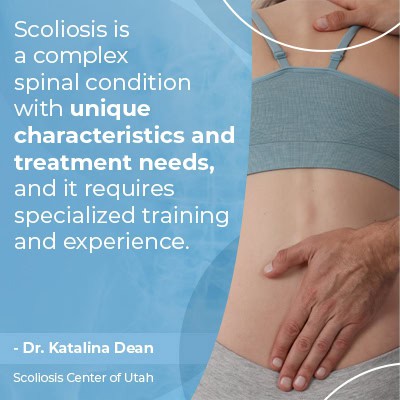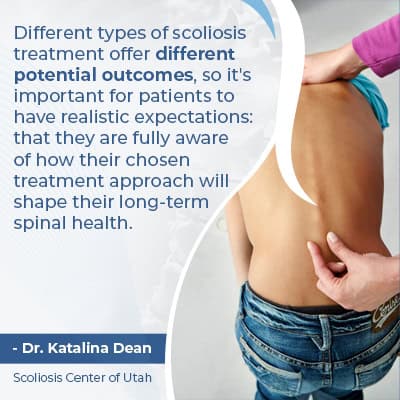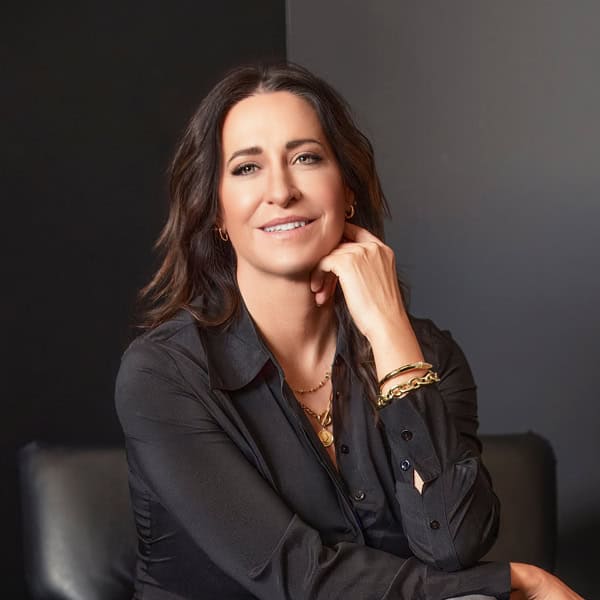Blogs
7 Must‑Know Scoliosis Questions for Patients: Answered!

Patients should feel comfortable asking their scoliosis treatment provider questions. In fact, I recommend asking the following seven questions to ensure the condition is understood, treatment options have been fully explained, and that treatment expectations are realistic.
For patients recently diagnosed with scoliosis, not only are questions natural, they’re necessary. Scoliosis is a complex spinal condition that’s progressive and needs to be taken seriously. It’s important that patients understand their condition and how different types of treatment shape future spinal health.
Before recommending seven questions every patient should ask a potential treatment provider, let’s talk generally about scoliosis.
Understanding Scoliosis
Scoliosis causes the spine to develop an unhealthy lateral curvature that disrupts the spine’s balance and stability.
A spine that doesn’t have its healthy and natural curves in place is one that’s not in alignment, and this can disrupt the body’s overall symmetry, balance, and stability.
The effects of a misaligned spine can be felt from the head to the feet.
The more severe cases cause the most noticeable effects, and as a complex spinal condition with different severity levels and types, treatment has to be individualized.
The most common form of scoliosis is adolescent idiopathic scoliosis, but the condition affects all ages from babies born with congenital scoliosis to the elderly developing degenerative scoliosis.
Scoliosis also ranges widely in severity from mild scoliosis to moderate and severe cases, and there are also different curvature types and patterns; the variance within the condition necessitates the complete customization of potentially-effective treatment plans.
Patients have to understand that as a progressive condition, most cases of scoliosis get worse over time, and different treatment approaches can have a different focus with different potential outcomes.
It’s important to feel comfortable with a treatment provider, and patients also have to fully understand the treatment being applied; the following questions can help.
1) Is scoliosis your specialty?
 Scoliosis is a complex spinal condition with unique characteristics and treatment needs, and it requires specialized training and experience.
Scoliosis is a complex spinal condition with unique characteristics and treatment needs, and it requires specialized training and experience.
Here at the Scoliosis Center of Utah, I specialize in non-invasive scoliosis bracing and postural correction and have an advance certification in Chiropractic BioPhysics®: currently, only 1 percent of the world’s chiropractors can offer this specialized approach.
A scoliosis specialist will understand how the condition affects not just the spine and its immediate surroundings, but the entire body, and can craft a customized treatment plan accordingly.
As there is so much variance within the condition, an individualized approach is necessary.
2) What is your treatment approach?
There are two main treatment options when it comes to addressing scoliosis: with surgery or with non-surgical conservative treatment options.
Traditional scoliosis treatment can funnel patients in the direction of scoliosis surgery because it doesn’t have a strategy for treating mild scoliosis proactively; this approach is more reactive and about responding when/if conditions become severe or are atypical.
Conservative treatment values a proactive response to a diagnosis by starting treatment immediately because in most cases, the milder scoliosis is when treatment is started, the more responsive it’s going to be.
Conservative treatment options are less invasive than surgical treatment options.
3) What is your treatment goal?
Treatment goal is part of what defines a treatment approach. As a progressive condition, the nature of scoliosis is to become more severe over time and with growth.
The goal of traditional surgical treatment is to stop scoliosis from progressing, and it does so by fusing the curve’s most-unnaturally tilted vertebrae into one solid bone so they can’t become more unnaturally tilted over time.
In most cases, metal rods are attached to the spine to hold the spine’s position, but this isn’t the same as having correction as the treatment goal.
Corrective treatment results means the spine’s unnatural curve and rotation is addressed on a structural level, and the spine’s surrounding muscles are strengthened for more spinal support/stability.
Stopping progression and correcting scoliosis are not the same; traditional treatment has the goal of stopping progression, while conservative treatment is working towards corrective results.
4) What is the potential outcome of your treatment plan?
 Different types of scoliosis treatment offer different potential outcomes, so it’s important for patients to have realistic expectations: that they are fully aware of how their chosen treatment approach will shape their long-term spinal health.
Different types of scoliosis treatment offer different potential outcomes, so it’s important for patients to have realistic expectations: that they are fully aware of how their chosen treatment approach will shape their long-term spinal health.
Traditional surgical treatment has the potential to straighten a bent spine, but it also has the potential to cause increased pain at the fusion site and a noticeable loss in spinal flexibility.
A spine with a limited range of motion can disrupt a person’s ability to participate in certain activities and impact overall quality of life.
Scoliosis that’s corrected through conservative treatment is going to mean a spine that’s stronger and has a more natural range of motion because the focus is on realigning the spine for more balance and stability.
5) How is pain management handled?
Not all scoliosis patients need pain management, but for those that do, this is an important question. Scoliosis becomes a compressive condition once growth has stopped and skeletal maturity has been reached, and this is when compression-related pain tends to become an issue.
So for adult patients, pain management is often a focus of treatment, and this can involve prescription pain medications and a variety of therapies, but it’s also important to understand that scoliosis pain is a symptom, so if the only response to pain is medication, this is not addressing the underlying cause of the pain: the condition itself.
So the best approach to sustainable and long-term scoliosis pain management is proactive treatment that targets the underlying cause of the pain.
6) As a conservative treatment provider, what are the treatment options applied?
One of the most significant benefits of non-surgical conservative treatment is that it’s innovative and integrative.
Here at the Center, a multifaceted treatment approach is applied so plans can be fully customized for the most specific results.
Conservative treatment options include corrective 3-dimensional bracing, Chiropractic BioPhysics® and ScoliBalance®: an individualized scoliosis-specific exercise program.
Together, these facets of treatment work together to impact conditions on every level.
7) Is rehabilitation part of your treatment?
Scoliosis treatment is about managing an ongoing condition, and conservative non-surgical treatment involves care from the time of diagnosis to the correction of the condition, and guidance and care after.
Continued chiropractic care and the prescription of scoliosis-specific exercises patients can easily continue from home are important for maintaining treatment results and leading a spine- and scoliosis-friendly lifestyle.
Conclusion
It’s natural for people being diagnosed with scoliosis to have a lot of questions.
Initially, patients’ questions are about the condition and understanding how it develops, progresses, and common symptoms, but it’s also important for patients to ask questions about the path of their treatment.
Those on the path of traditional scoliosis treatment are commonly recommended for spinal fusion surgery for severe and/or atypical types of scoliosis, but little is done beforehand when it comes to preventing progression.
Conservative treatment has the goal of preventing progression and the need for invasive surgery by being proactive and applying multiple different types of treatment.
Here at the Center, patients benefit from a 3-dimensional approach to correcting a 3-dimensional condition, and this includes corrective bracing, ScoliBalance® therapy, and Chiropractic BioPhysics®.
Through targeting the structural abnormality within the spine with chiropractic care, pushing the spine into a corrective position with the 3-dimensional ScoliBrace®, and the use of scoliosis-specific exercise, progression can be slowed/stopped, the spine’s balance and alignment can be improved, the spine’s surrounding muscles can be balanced and strengthened, pain can be managed, and the risk of falling for adults is reduced.
It’s important that patients understand both their condition and the different types of treatment.
Surgical treatment can address the unnatural curvature of the spine, but the way it does so works against the spine’s natural movement-based design so can result in a spine that’s more rigid with a reduced range of motion; in addition, fused spines are weaker and more vulnerable to strain and injury.
Conservative treatment prioritizes the spine’s long-term health and function by working to address the underlying cause of the pain and postural changes: the misalignment of the spine.
As conservative treatment is less invasive, it doesn’t come with the potential risks of a surgical response, but patients also need to understand that regardless of the type of treatment applied, results can never be guaranteed.
When it comes to scoliosis, the sooner treatment is started, the more effective it’s likely to be, so don’t hesitate to reach out if you, or someone you care about, is showing signs of scoliosis.

Dr. Katalina Dean
Dr. Katalina Dean is the founder and clinical director of Scoliosis Center of Utah, in Midvale, UT. Her team specializes in posture correction, spinal rehabilitation, and non-invasive scoliosis care and bracing.
Call Today
Do You Qualify for Care?
Schedule an Appointment Below
